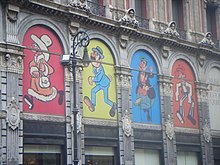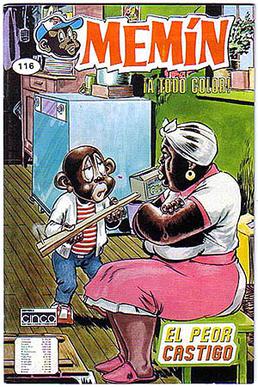
Memín Pinguín was a Mexican comic book character. He was created in 1943 by writer Yolanda Vargas Dulché. Alberto Cabrera took over drawing from 1953 until 1962, followed by Sixto Valencia Burgos.
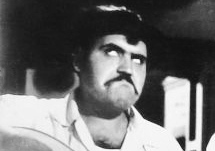
Gaspar Henaine, more commonly known by his pseudonym Capulina, was a Mexican comedian, actor, singer, film producer, and screenwriter. He is best known for partnering with Marco Antonio Campos as the double act Viruta and Capulina and for his subsequent solo career. He was later given the nickname "El Rey del Humorismo Blanco", due to his clean, innocent style of comedy.
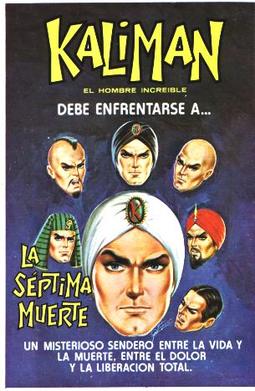
Kalimán or Kalimán, the Incredible Man is a popular Mexican adventurer superhero, created by Rafael Cutberto Navarro and Modesto Vázquez González in 1963. He is the main character of the radio drama bearing his name, which depicts the adventures of Kalimán, a descendant of the Egyptian Pharaohs, and his young companion, Solín. Kalimán is very well known and popular across Latin America, and the radio series spawned a comic book series and two film adaptations. The adventures of Kalimán were published as a serialized weekly comic, and printed for twenty-six consecutive years, with the series reaching its highest popularity in 1965; it is still quite popular today in reprints and in paperback format. Kalimán himself is considered as a Mexican pop culture icon and one of the first and most representative examples of Mexican superheroes.
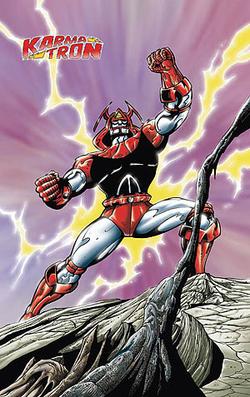
Karmatrón y los Transformables is a Mexican science fiction and fantasy comic book created by Oscar González Loyo, and published in 1986 by CEPSA. The weekly series was published only in Mexico, non-stop and during 5 years, from 1986 to 1991 (#298).

Yolanda Vargas Dulché de la Parra was a Mexican writer principally known for the creation of the comic book character of Memín Pinguín and various telenovelas for Mexican television. She began her writing career as a way to supplement income for several newspapers, creating Memín Penguín in 1943. By 1960, she has successfully published a number of comic books, encouraging her husband, Guillermo de la Parra, to write as well. The two went on to create various successful telenovelas including Rubí, which has been redone for both television and film. In total Varga Dulché published over sixty titles in both Mexico and abroad.
Oscar González Loyo was a comic book artist, author of Karmatrón y Los Transformables. González Loyo was the son of late comic book artist Oscar González Guerrero. He was also the founder and a main partner of the company ¡Ka-Boom! Estudio.
Oscar González Guerrero was a comic book artist mostly known for his co-creation of Zor y Los Invencibles and Hermelinda Linda. He was the artistic director of ¡Ka-Boom! Estudio, a family-owned company of local comics, founded in 1994 with his son and his son's girlfriend, Susana Romero.
Grupo Editorial Vid was a Mexican comic, manga and books publisher. It was funded in the early 1940s as Editorial Argumentos (EDAR). Many of their books are sold from around 30 pesos for comics up to 60 Pesos for manga. Both comics and manga are released monthly.

Argentine comics are one of the most important comic traditions internationally, and the most important within Latin America, living its "Golden Age" between the 1940s and the 1960s. Soon after, in 1970, the theorist Oscar Masotta synthesized its contributions in the development of their own models of action comics, humor comics and folkloric comics and the presence of other artists.

Gabriel Bernal Vargas was a Mexican cartoonist, whose comic strip La Familia Burrón was created in 1937. This cartoon has been described as one of the most important in Mexican popular culture. Vargas won Mexico's "Premio Nacional de Periodismo" in 1983 and the "Premio Nacional de Ciencias y Artes en el área de Tradiciones Populares" in 2003.

Manuel Leal, better known as Tinieblas ("Darkness"), is a Mexican luchador.
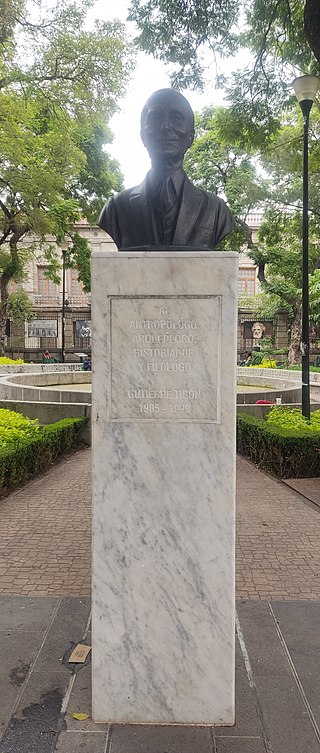
Gutierre Tibón was an Italian-Mexican writer. He wrote widely on issues of cultural identity, mixing ideas from anthropology, linguistics, psychology, philosophy, ethnology, sociology, and political science.

Lalo Alcaraz is an American cartoonist most known for being the author of the comic La Cucaracha, the first nationally syndicated, politically themed Latino daily comic strip. Launched in 2002, La Cucaracha has become one of the most controversial in the history of American comic strips.

Calzonzin Inspector is a 1974 Mexican comedy film and live action comic adaptation directed and starred by Alfonso Arau. It was selected as the Mexican entry for the Best Foreign Language Film at the 47th Academy Awards, but was not accepted as a nominee.

KeMonito is a Mexican Mascota enmascarado, or masked professional wrestling manager/mascot currently working for the Mexican professional wrestling promotion Consejo Mundial de Lucha Libre (CMLL) portraying a tecnico wrestling character. As KeMonito he accompanies and helps various tecnicos in CMLL, a role he used to fill for Tinieblas under the name "Alushe". As KeMonito he wears a full bodysuit that resembles that of a monkey with blue fur and yellow skin, as Alushe he wore a furry full bodysuit resembling an Ewok.
La Familia Burrón is a Mexican comic created in 1948 by Gabriel Vargas. During its more than 60 years of publication, it published 500,000 copies, making it one of the longest running publications in the world. The cartoon follows the adventures of a lower-class Mexico City family with the surname Burrón it may possibly reference the use of “albures” the art of double entendres. One of the main characteristics of The Burrón Family is its excessive use of slang, contractions, or invented words in almost every dialogue, creating a particular and original invented language that is unique in the world of comics.
